It's In the Can
- William Darron

- Mar 14, 2023
- 3 min read
If you are a regular rider or walker on the Lehigh Trail in Rush, you might be passing by one of the last remnants of big business in the town, and you probably didn't even know it.

It's official address is 6180 Rush Lima Road, but it isn't really on the street. It's a big empty building alongside the trail. No driveway. What is it?

It's probably the last remaining building of the Rush canning company that for a time in the early part of the 20th century was one of the biggest businesses in Rush. One that was formed and up and running in under a year. It made thousands of dollars for many Rush residents.

In the early 1890's the Lehigh Valley Railroad company ran it's main line to Buffalo through the town of Rush.

Think of it like the Internet of today. High speed transport right through the middle of town, ready to take you or your stuff to other places. For people it meant a ride to the city, and for farmers a way to get their crops to market.

In early 1900, enterprising developers showed up with a proposition. They would provide the infrastructure to run a canning factory. They would pay the farmers for their crops, preserve them, can them, and then they could be shipped to market by rail. Townspeople could buy stock in the company. If it turned a profit, they would get a dividend. Perhaps the value of the company would go up, and their $100 shares would increase in value. Back in 1900, a $100 investment was about the same as $3,500 is today.

By March the company had secured permission to build on land owned by the railroad along the tracks. The canning factory opened and farmers from all about brought in cherries and corn and beans and peas and whatever else the company could preserve and sell.
Rush was the envy of many a town. By 1906 the people in Caledonia took notice and began to publish an appeal to get their own canning company. Why? Just look at the comment of the Monroe County Treasurer (the guy that collects the taxes):
He said that people there [Rush] that heretofore never could be trusted were paying up their debts and money was very plentiful and business excellent. He gave the canning factory the credit for doing it too.

But alas, the original developers were "under capitalized" and the initial company that issued the stock (Genesee Valley Preserving Company) went out of business in 1910. But the good news was that another canning company bought out the concern in Rush.

By 1913, the treasurer of the Wilson Canning company, W. H. Osborn, struck out on his own and built a larger canning company in Honeoye Falls and also bought the Rush canning factory. For awhile both the Rush and Honeoye Falls plants accepted the crops of farmers and employed many people doing the processing.

The canning factory had an electric generator (possibly what was housed was in that building that still exists.) The electricity that ran the plant was connected to Kinsey's Hall which was a store, dance hall, and also the "Town Hall".

So development is actually good if managed properly. In a matter of 20 years, Rush went from a poor rural town to a thriving village. Since then, most all of the businesses are gone and so are the opportunities that they provided.
Here at the Echo, we are saying a prayer that more opportunity lies ahead.




Comments